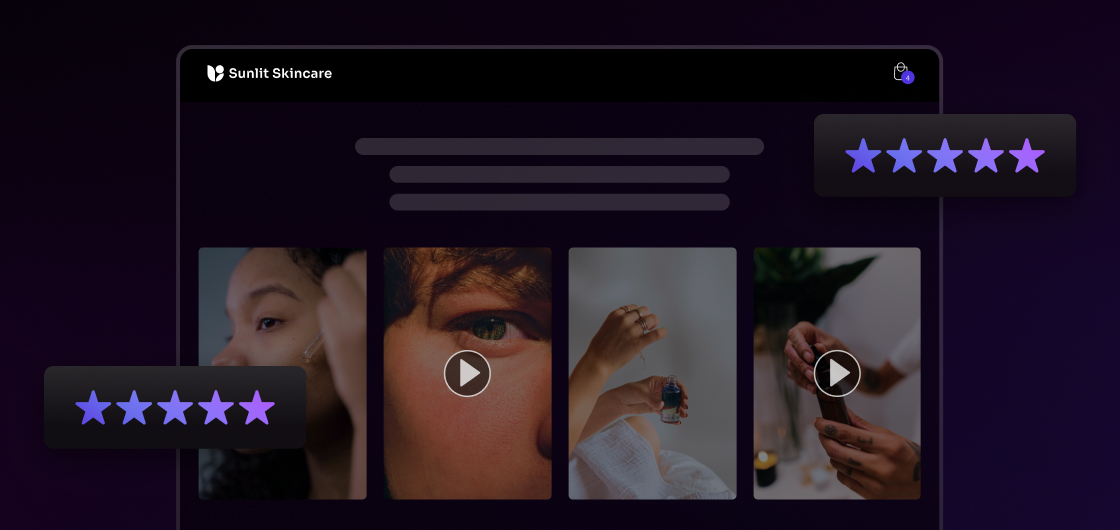
- Customer Marketing
- Reviews and UGC
- Social Proof
How To Add Social Proof on Shopify
Katie Vaught | Apr 25, 2025
Apr 25, 2025 | 15 minute read

Katie Vaught
Product Marketing Manager
Positive reviews carry serious weight when it comes to purchase decisions, especially in ecommerce, where customers are removed from the brand and can’t experience the product firsthand. Earning their confidence often takes more effort.
People have come to rely on the opinions of others to guide their online purchasing decisions—and for Shopify store owners, social proof has become an essential part of marketing your online store. Social proof builds customer trust, increases conversion rates by as much as 34%1, and fosters long-term brand loyalty.
With the rise of social media, social proof can take many forms, but the end result remains the same: bridging the gap between you and your customers. Shoppers are more likely to buy when they see that others have made a purchase and enjoyed their experience. Whether it’s a five-star review, a video review offering candid, honest feedback, or a photo of a happy customer, social proof creates brand confidence.
One of the most common misconceptions about adding social proof to your online store is that it’s incredibly costly and requires advanced coding knowledge that you’d need to outsource. While this may have been true 15 years ago, it isn’t the case anymore. There are now several tools available that make it easy to collect product reviews, user-generated content, influencer testimonials, and other pieces of social proof and display them in a visually appealing way.
This article will break down the ways you can add social proof to your Shopify store and give you real-world tactics you can implement immediately. Whether you’re just launching your storefront or looking to boost conversions on an existing one, this guide will show you how to effectively leverage social proof on Shopify.
Social proof is a psychological phenomenon where individuals look to the actions or opinions of others to guide their own behavior, typically in uncertain situations. In ecommerce, social proof is most frequently used to influence potential customers toward a purchasing decision. Once they see that others have purchased a product or reviewed it highly, they view the store as more credible. Depending on how much value they place on the review, rating, or testimonial, it can make the difference between a sale and a missed opportunity.
Some brands build social proof into the core of their business model and see remarkable results by doing so. Take Australian skincare brand MooGoo, for example. This brand leveraged Okendo’s platform to boost customer trust and conversions by integrating user-generated reviews across marketing channels and personalizing the shopping experience with a product recommendation quiz. Seamless integration with Shopify and Klaviyo also set the stage for advanced segmentation and targeted marketing.
This approach builds trust, drives conversions, and fuels the kind of brand loyalty that keeps customers returning. Integrating different types of social proof into your Shopify store can create a similar environment of trust and authenticity, leading to higher customer engagement and sales conversions.
Now that you know how social proof can give credibility to your brand, foster customer trust, and boost conversions in your Shopify store, it’s time to learn what types of social proof you can use and how you can implement them. Here are five effective types of social proof to consider:
Perhaps the most fundamental form of social proof for your ecommerce store, written customer reviews and ratings showcase the quality of your product at scale. Prominently displaying star ratings and detailed reviews gives potential customers a snapshot of the satisfaction associated with your products.
Almost all customers read online reviews before finalizing a purchase, making reviews a necessary part of the buying process. Here are some best practices for sourcing and displaying reviews in your Shopify store:

Perhaps the most authentic form of review content is user-generated content (UGC). Customer-submitted photos, videos, and testimonials add authenticity to your brand and products.
Since UGC comes from real users of your products, it immediately builds trust with potential customers; especially with the advent of social media, consumers are accustomed to outsourcing product research to trusted creators online. Sourcing UGC can be difficult, so here are some tips for implementing this social proof example:

Over the last twenty years, social media has become a vital part of marketing your brand because of its direct access to your target audience and platform for storytelling. Highlighting influencer mentions and tagged posts provides third-party validation for your store. Embedding social media feeds in your Shopify store provides real-time interactions and shows your brand’s popularity. Here are some best practices:
Perhaps one of the most overlooked forms of social proof is site security. Shoppers are rightfully cautious about entering payment information online, and trust badges go a long way in easing those fears. Displaying security and certification badges builds confidence, especially near high-stakes conversion points. You don’t want to lose a potential customer who abandons their cart because they don’t see social proof of a secure checkout process.
Product research in 2025 looks very different than it did in 2015. According to Adobe, 40% of consumers3 now use TikTok as a search tool—and that number jumps to 64% for Gen Z. Identifying and working with influencers in your industry has never been more important—or achievable.
Influencers with large followings have major sway over public perception, and collaborations can introduce your brand to entirely new audiences. Here are some best practices for influencer marketing:
Measure the impact. Track conversions from influencer campaigns with affiliate codes or UTM links to ensure your investments are delivering results.
Shopify has revolutionized ecommerce. However, while it’s never been easier to sell your products online, it’s also never been more difficult to break through the noise. One of the most efficient ways to set your brand apart is by integrating social proof into your Shopify store by using Okendo Reviews.
Social proof builds trust, influences purchasing decisions, fosters customer loyalty, and boosts conversions. Here are the ways social proof can make a transformative impact on your Shopify store:
Some of the most successful Shopify storefronts use social proof to increase brand credibility, foster customer trust, and drive conversions. For example, Barstool Store, a leading lifestyle brand on Shopify, uses Okendo to showcase reviews and fan-driven content to build community trust. By turning their customers into advocates, they’ve scaled their Shopify storefront into a multimillion-dollar operation rooted in social proof.
The most dynamic and engaging form of social proof? Video testimonials. These allow potential buyers to hear and see real customers discussing your products—greatly influencing their purchasing decisions. While video testimonials are arguably the most powerful social proof you can use, they’re also the hardest to source and display. Here are some best practices for video testimonials:

The easiest social proof to source and feature, star ratings, are more powerful with larger sample sizes. For example, a 4.7-star average from 5,000 customers may speak more loudly than a perfect 5-star average review from 5 customers; make sure you show how many people have rated your product. Visible star ratings provide a quick visual cue about a product’s quality, heavily influencing consumer behavior. Here are some tips for implementation:
The most time-tested form of social proof, the written review, provides detailed insights into product performance and customer satisfaction, helping potential buyers make informed decisions.
Social Media interactions act as public endorsements and boost your brand’s credibility. UGC shared online acts as organic marketing, showing how real customers enjoy your products.
Respond promptly and always give other users a path to your page when interacting online. Here are a few strategies that can improve your social media presence:
Featuring real-life photos of customers using your products not only builds confidence in those products but also helps potential buyers visualize them in their own lives—significantly increasing the likelihood of purchases.
When implemented correctly, these forms of social proof not only make a better shopping experience for your customers, they also build a trustworthy brand image that resonates with your audience.
If you want your reviews and user-generated content to actually influence buying behavior, how and where you showcase them matters. Keep these simple best practices in mind:
As a general rule of thumb, featuring social proof in high-visibility areas of your website—like your homepage, product listing pages, product detail pages, or at checkout—is the most effective way to maximize impact. These touchpoints are where customers make purchasing decisions, so displaying third-party validation on them can significantly boost conversions.
Recent reviews build credibility. Use tools like Okendo Reviews to automate review requests and keep your content up to date without adding manual tasks to your team’s plate.
Shoppers can spot overly polished or curated content. Therefore, brands should prioritize showcasing real customer experiences, both positive and negative, to establish brand trust and transparency.
Social proof is a game-changer for your Shopify store, but the process of collecting and displaying reviews, video testimonials, and user-generated content can be time-consuming. Okendo Reviews offers automation that makes sourcing social proof easy and includes multiple review widget displays that allow you to showcase feedback authentically across your Shopify store.
This tool has a robust feature set and a user-friendly design, allowing for in-depth customization, in-line product review widgets, media carousels, and photo/video grids. Its Q&A feature lets customers ask questions and receive answers in real-time, while dedicated review pages help shoppers who are specifically searching for your brand discover your top-rated products and reviews.
Some of Okendo’s more innovative features include featured reviews which let brands pin top-rated feedback to the top of the widget, and AI-generated review summaries which give shoppers quick product insights that keeps them engaged, and drives more conversions. Brands can adjust the tone, length, prefix, and language of their AI summaries, so every summary feels like a natural extension of your brand. It’s a powerful platform that turns satisfied customers into loyal brand advocates.

Social proof for an online brand is undeniably beneficial. Here are some quick answers to common questions about using social proof apps.
Okendo Reviews integrates seamlessly with Shopify. Installation is quick, and setup guides walk you through the process step-by-step.
Yes—brands using Okendo Reviews and other Okendo products have seen conversion rates improve by up to 4x. Social proof gives shoppers confidence, and confidence leads to purchases.
Okendo’s support team offers in-depth documentation and live support, making troubleshooting fast and straightforward.
Social proof isn’t just a nice added feature—it’s an absolute necessity for ecommerce brands in 2025. For the vast majority of online customers, social proof is a key factor in making purchasing decisions. And with Okendo Reviews, it’s never been easier to highlight your happy customers. Make the most of social proof on your Shopify storefront by booking a demo with Okendo today.
Related articles
Ready to learn more?